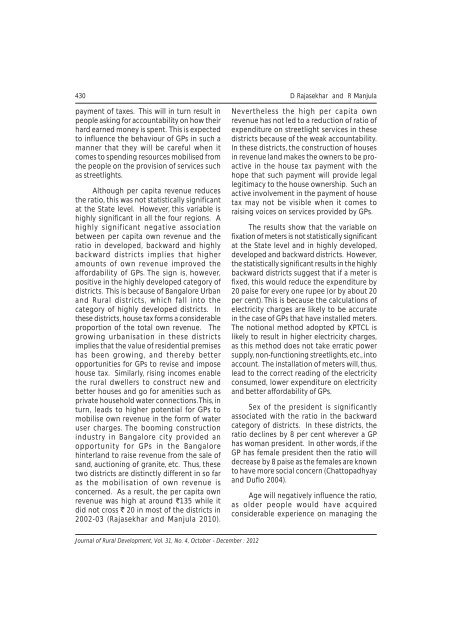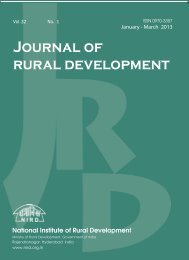October - December 2012 - National Institute of Rural Development
October - December 2012 - National Institute of Rural Development
October - December 2012 - National Institute of Rural Development
- No tags were found...
You also want an ePaper? Increase the reach of your titles
YUMPU automatically turns print PDFs into web optimized ePapers that Google loves.
430 D Rajasekhar and R Manjulapayment <strong>of</strong> taxes. This will in turn result inpeople asking for accountability on how theirhard earned money is spent. This is expectedto influence the behaviour <strong>of</strong> GPs in such amanner that they will be careful when itcomes to spending resources mobilised fromthe people on the provision <strong>of</strong> services suchas streetlights.Although per capita revenue reducesthe ratio, this was not statistically significantat the State level. However, this variable ishighly significant in all the four regions. Ahighly significant negative associationbetween per capita own revenue and theratio in developed, backward and highlybackward districts implies that higheramounts <strong>of</strong> own revenue improved theaffordability <strong>of</strong> GPs. The sign is, however,positive in the highly developed category <strong>of</strong>districts. This is because <strong>of</strong> Bangalore Urbanand <strong>Rural</strong> districts, which fall into thecategory <strong>of</strong> highly developed districts. Inthese districts, house tax forms a considerableproportion <strong>of</strong> the total own revenue. Thegrowing urbanisation in these districtsimplies that the value <strong>of</strong> residential premiseshas been growing, and thereby betteropportunities for GPs to revise and imposehouse tax. Similarly, rising incomes enablethe rural dwellers to construct new andbetter houses and go for amenities such asprivate household water connections. This, inturn, leads to higher potential for GPs tomobilise own revenue in the form <strong>of</strong> wateruser charges. The booming constructionindustry in Bangalore city provided anopportunity for GPs in the Bangalorehinterland to raise revenue from the sale <strong>of</strong>sand, auctioning <strong>of</strong> granite, etc. Thus, thesetwo districts are distinctly different in so faras the mobilisation <strong>of</strong> own revenue isconcerned. As a result, the per capita ownrevenue was high at around `135 while itdid not cross ` 20 in most <strong>of</strong> the districts in2002-03 (Rajasekhar and Manjula 2010).Nevertheless the high per capita ownrevenue has not led to a reduction <strong>of</strong> ratio <strong>of</strong>expenditure on streetlight services in thesedistricts because <strong>of</strong> the weak accountability.In these districts, the construction <strong>of</strong> housesin revenue land makes the owners to be proactivein the house tax payment with thehope that such payment will provide legallegitimacy to the house ownership. Such anactive involvement in the payment <strong>of</strong> housetax may not be visible when it comes toraising voices on services provided by GPs.The results show that the variable onfixation <strong>of</strong> meters is not statistically significantat the State level and in highly developed,developed and backward districts. However,the statistically significant results in the highlybackward districts suggest that if a meter isfixed, this would reduce the expenditure by20 paise for every one rupee (or by about 20per cent). This is because the calculations <strong>of</strong>electricity charges are likely to be accuratein the case <strong>of</strong> GPs that have installed meters.The notional method adopted by KPTCL islikely to result in higher electricity charges,as this method does not take erratic powersupply, non-functioning streetlights, etc., intoaccount. The installation <strong>of</strong> meters will, thus,lead to the correct reading <strong>of</strong> the electricityconsumed, lower expenditure on electricityand better affordability <strong>of</strong> GPs.Sex <strong>of</strong> the president is significantlyassociated with the ratio in the backwardcategory <strong>of</strong> districts. In these districts, theratio declines by 8 per cent wherever a GPhas woman president. In other words, if theGP has female president then the ratio willdecrease by 8 paise as the females are knownto have more social concern (Chattopadhyayand Duflo 2004).Age will negatively influence the ratio,as older people would have acquiredconsiderable experience on managing theJournal <strong>of</strong> <strong>Rural</strong> <strong>Development</strong>, Vol. 31, No. 4, <strong>October</strong> - <strong>December</strong> : <strong>2012</strong>

















